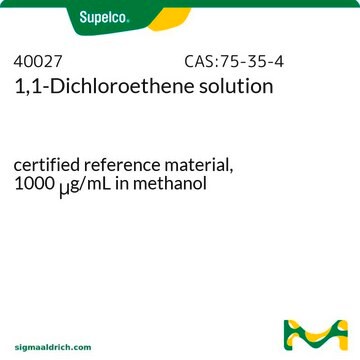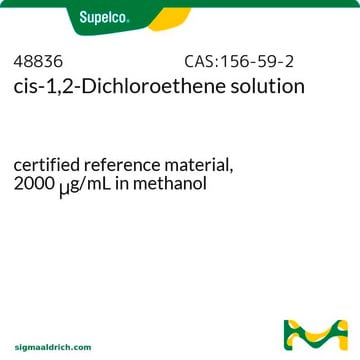163023
1,1-Dichloroethylene
contains 200 ppm MEHQ as inhibitor, 99%
Synonym(s):
Vinylidene chloride
Sign Into View Organizational & Contract Pricing
All Photos(3)
About This Item
Linear Formula:
CH2=CCl2
CAS Number:
Molecular Weight:
96.94
Beilstein:
1733365
EC Number:
MDL number:
UNSPSC Code:
12162002
PubChem Substance ID:
NACRES:
NA.23
Recommended Products
vapor density
3.46 (vs air)
vapor pressure
9.68 psi ( 20 °C)
Assay
99%
form
liquid
autoignition temp.
968 °F
contains
200 ppm MEHQ as inhibitor
expl. lim.
15.5 %
bp
30-32 °C (lit.)
mp
−122 °C (lit.)
density
1.213 g/mL at 20 °C (lit.)
storage temp.
2-8°C
SMILES string
ClC(Cl)=C
InChI
1S/C2H2Cl2/c1-2(3)4/h1H2
InChI key
LGXVIGDEPROXKC-UHFFFAOYSA-N
Looking for similar products? Visit Product Comparison Guide
Application
1,1-Dichloroethylene can be used as a monomer to synthesize polymercomposite latexes by emulsion polymerization.
Signal Word
Danger
Hazard Statements
Precautionary Statements
Hazard Classifications
Acute Tox. 3 Oral - Acute Tox. 4 Inhalation - Carc. 2 - Eye Irrit. 2 - Flam. Liq. 1 - Skin Irrit. 2
Storage Class Code
3 - Flammable liquids
WGK
WGK 3
Flash Point(F)
-2.2 °F
Flash Point(C)
-19 °C
Personal Protective Equipment
dust mask type N95 (US), Eyeshields, Gloves
Choose from one of the most recent versions:
Already Own This Product?
Find documentation for the products that you have recently purchased in the Document Library.
Customers Also Viewed
Fan Chen et al.
Frontiers in microbiology, 9, 2306-2306 (2018-10-17)
Bioelectrochemical systems (BESs) are regarded as a promising approach for the enhanced dechlorination of chlorinated aliphatic hydrocarbons (CAHs). However, the electron distribution and transfer considering dechlorination, methanogenesis, and other bioprocesses in these systems are little understood. This study investigated the
Masarin Ban et al.
Toxicology, 226(2-3), 161-171 (2006-08-02)
Occupational allergy and asthma is a challenging issue in the developing countries. Chemicals inhaled in the workplaces may act not only as allergens but also as immune response modifiers, contributing to asthma exacerbation. In this study, we tested the adjuvant
Erik J Martin et al.
The Journal of pharmacology and experimental therapeutics, 313(1), 95-103 (2005-01-01)
1,1-Dichloroethylene (DCE) causes pulmonary injury that is characterized by necrosis of bronchiolar Clara cells. Mitochondria have been identified as an early target in the toxic response. Because mitochondria have been implicated in both necrotic and apoptotic cell death, we have
Daniel B Cope et al.
Environmental science & technology, 43(1), 169-175 (2009-02-13)
A feasibility study was conducted using slags from six grey-iron foundries to evaluate their potential as reactive media for permeable reactive barriers (PRBs) to remove aqueous trichloroethylene (TCE) from groundwater. Batch tests indicated that the slags exhibit varying degrees of
Young Kim et al.
Biotechnology and bioengineering, 80(5), 498-508 (2002-10-02)
Batch kinetic and inhibition studies were performed for the aerobic cometabolism of 1,1,1-trichloroethane (1,1,1-TCA), 1,1-dichloroethylene (1,1-DCE), and 1,1-dichloroethane (1,1-DCA) by a butane-grown mixed culture. These chlorinated aliphatic hydrocarbons (CAHs) are often found together as cocontaminants in groundwater. The maximum degradation
Our team of scientists has experience in all areas of research including Life Science, Material Science, Chemical Synthesis, Chromatography, Analytical and many others.
Contact Technical Service












